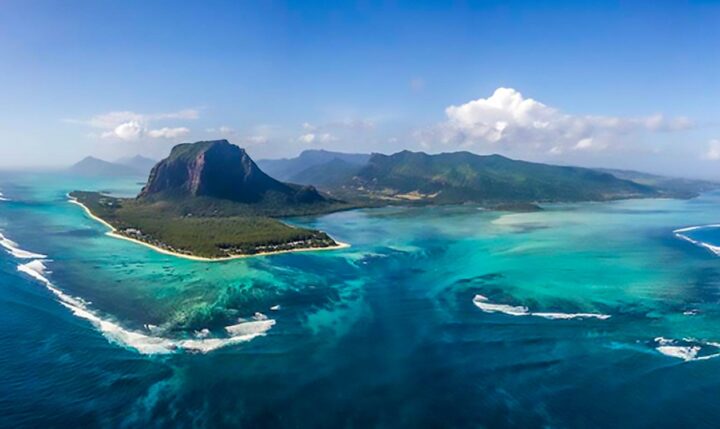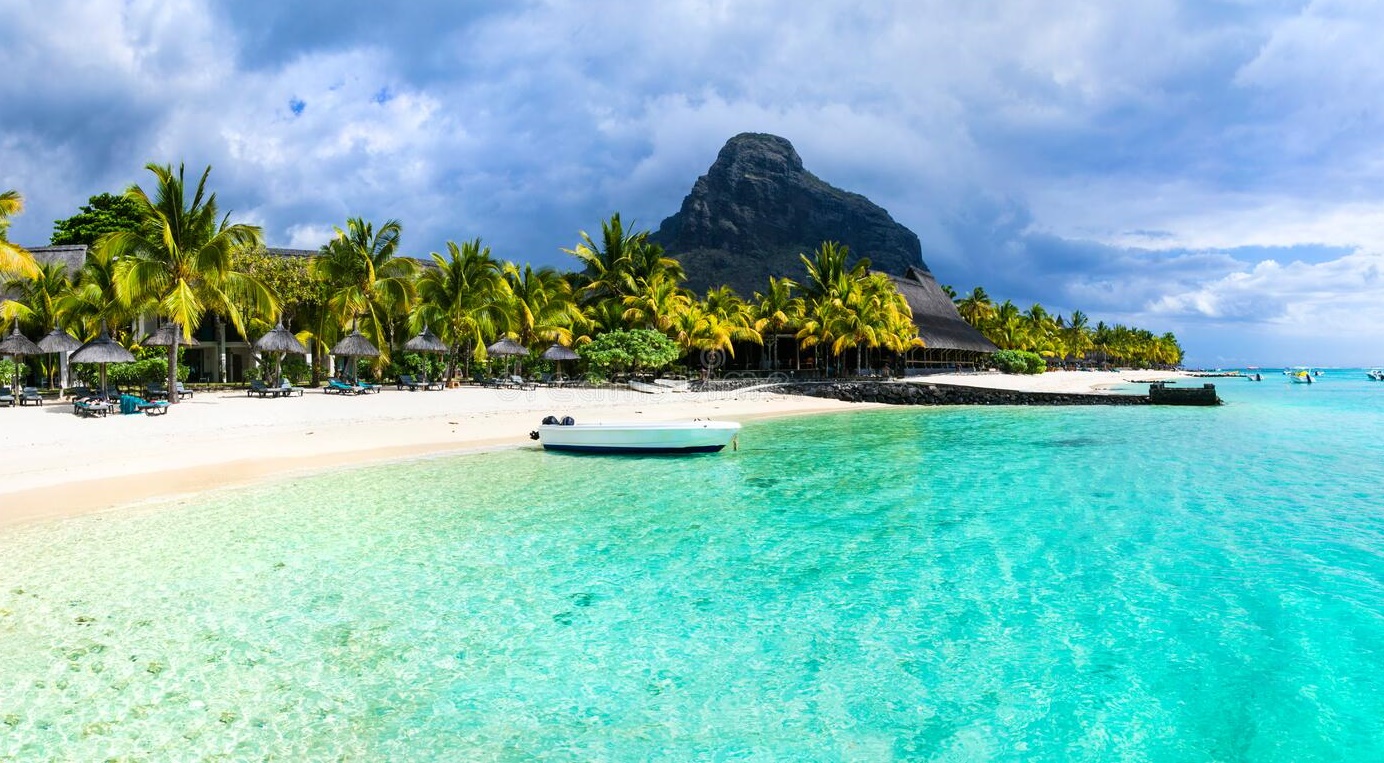
Discover Mauritius! / Mauritius Travel Guide
Multifaceted, luxurious, sun-kissed: When you think of Mauritius, you inevitably have images of white dream beaches with swaying palm trees, turquoise blue water and an evergreen island pearl of the Indian Ocean in mind.
Anyone longing for a luxurious holiday with a touch of the exotic will find what they are looking for here. But Mauritius offers so much more!
After two grueling years, we have really earned a dream holiday, as it is written in the book. Mauritius gives you the opportunity to really let your soul dangle, to indulge in luxury and, incidentally, to experience multi-faceted adventures on an island of contrasts. We’ll show you why a trip is worthwhile.
When is the best time to visit Mauritius?
Good news first: Summer temperatures await you on the sun-drenched island in the Indian Ocean for a full twelve months. From May to November is the dry season, while from January to March the climate is hot, muggy and oppressive, as you can see from our climate table. The months of September to November and April to June are considered to be the best travel times, because then it is particularly pleasant, not too hot and, above all, it is not the main season.
For whom is Mauritius the ideal travel destination?
Attention honeymooners! Mauritius is the honeymoon destination par excellence, which is why many happy couples cavort on the island. Many hotels have specialized in honeymoons and offer their guests romantic moments and unforgettable moments for two. Beach lovers who want to combine their beach vacation with sightseeing and culture or one or the other adventure in the Mauritian rainforest will also find a great travel destination here. The same goes for families, of course.
Water sports enthusiasts and active vacationers also get their money’s worth in Mauritius, both on and under the water. Whether snorkeling, diving, sailing, surfing or kite surfing: Thanks to the numerous water activities, there is definitely no chance of boredom!
Cultural diversity in Mauritius / Mauritius Travel Guide
Diverse is probably the right word to describe the culture of the island. Its inhabitants originally come from Europe, Africa, Madagascar and Asia, a mix that is hard to find anywhere else in the world. It is not for nothing that Mauritius adorns itself with the nickname “Island of Continents”. But although the whole world seems to come together on one island, there is peace and acceptance of the other culture and religion. Mauritians are Christian, Buddhist or Muslim, and you may find a white mosque, a colorful Hindu temple, a church and a pagoda on the same street.
The cultural diversity is also reflected in the celebrations of the island, so that the Indian Spring Festival – also known as the Holi Festival -, the Chinese New Year, Christmas and Easter are celebrated here in equal measure. Usually with lots of dancing and good food.
Speaking of food: Just like the Mauritians themselves, the Mauritian food culture is a colorful mixture of Indian, African and Chinese influences. The “Creole cuisine”, as it is called, is therefore always well seasoned and usually quite spicy. In addition to curries in all variations and degrees of spiciness, samosas (fried dumplings filled with meat or vegetables) are a popular street food in Mauritius. The numerous Biryani creations – fried or deep-fried rice with meat, seafood or vegetables – also make your mouth water. Fresh tropical fruits such as jackfruit, lychee, mango, guava, pineapple, coconut and papaya, which you can buy at street markets in the capital Port Louis, at every stall or on the beach, round off the taste experience wonderfully.
Incidentally, the mother tongue and everyday language is Morisyen, a Creole language that is related to French and is spoken almost exclusively on the streets. French, on the other hand, dominates the media, but the Mauritians also speak English – the official language of the country. There are also variations of Indian, Chinese or even some German.
Mauritius: top sights and highlights

1. Dream beaches as far as the eye can see
Beaches are the be-all and end-all in Mauritius and are among the island’s top attractions. Probably the most well-known holiday resort in the north of Mauritius is Grand Baie. The beach of the same name is less suitable for swimming and relaxing, but if you feel like taking a boat tour, you’ve come to the right place. If you want to relax, you will find one of the most beautiful beaches on the island not far away: Trou aux Biches Beach. The white, seemingly endless dream beach turns out to be a real eye-catcher in every Instagram profile and makes every beach lover’s heart beat faster.
The west also lures with real beach beauties, above all Flic en Flac Beach. The filao forests planted there provide plenty of shade and are also very popular with locals on weekends. A little further south, at the foot of the famous Table Mountain, kitesurfers and windsurfers from all over the world let off steam at Le Morne Beach. The wind conditions on the beach are particularly good from April to November, which makes the beach on the south-western tip of the island a true paradise for professional water sports enthusiasts. If, on the other hand, your heart beats more for surfing, Tamarin Beach is an excellent choice. A little tip: If you don’t dare to go on a board, you can look out for dolphins on a walk on the beach, which are particularly common here.
It is a little quieter on the east coast of Mauritius. Here you can choose between crystal clear lagoons, extensive beaches and paradise islands. While Belle Mare Beach showcases pristine Mauritius at its finest, the term ‘bright white’ takes on a whole new meaning on stunning Île aux Cerfs. The boat trip from Trou d’Eau Douche to the small island alone leaves many mouths open. Once there, even the biggest skeptics have no more doubts that they are in one of the most beautiful spots of the Indian Ocean.
2. The underwater world / Mauritius Travel Guide
The fact that a breathtaking underwater world is hidden under the shimmering, turquoise-blue water will probably not surprise anyone. The Blue Bay Lagoon in the southeast of Mauritius, which is listed as a marine national park, lives up to its name. The different shades of blue and probably the most colorful coral reef on the island make the lagoon a popular diving and snorkeling spot – if not the most popular – especially for beginners. A variety of colorful fish can be seen here including wrasse, clownfish, angelfish, parrotfish but also amazing corals and mangroves.
Furthermore, the crystal-clear lagoon of Pereybere in the north of Mauritius is a fantastic place for all snorkeling fans among you, which convinces mainly because of its size and depth. Here, too, you will encounter an unbelievable variety of sea creatures!
On the other hand, a nice photo spot is the Crystal Rock, a huge boulder that juts out of the water idyllically in a lagoon near the island of Île aux Benitiers in southwest Mauritius. Here, too, many colorful sea creatures cavort around the rocks and the water is truly crystal clear.
Speaking of the underwater world: have you ever heard of an underwater waterfall? This mysterious natural phenomenon is unique in the world and can be seen from the air on the southwestern tip of Mauritius. It seems like the sea is swallowing tons of water, but it’s just an optical illusion. Because it is not masses of water that fall here, but masses of sand, creating this spectacular illusion!
3. Black River Gorges National Park & the Seven Colored Earths
The Black River Gorges National Park is the larger and most famous of the two national parks in Mauritius. In addition to various native animal species, you can explore the unique natural landscapes of the park in the southwest of the island on countless hiking trails that stretch over 60 kilometers through the lush greenery. You might even get lucky birdwatching and spot three of the island’s most endangered bird species: the Mauritius falcon, the echoing parakeet and the pink dove.
But the south of the island has even more natural highlights waiting for you in the densely overgrown rainforest. How about a meter high waterfall? In fact, you don’t have to miss the one in Mauritius either! To do this, drive in the direction of Chamarel and climb a staircase directly behind the small mountain village. Here are two viewing platforms from which you can watch the Chamarel Waterfall as it cascades down a rock face in two broad jets nearly 100 meters high. Here at the latest you won’t be able to stop being amazed, I promise!
A little further down the street, on the other hand, things get particularly colourful. We are talking about the Seven Colored Earth Geopark. It is considered a geological phenomenon that is unique in the world: as the name suggests, seven different soils have been mixed together here by volcanic activity, forming a veritable rainbow of red, brown, purple, green, blue, purple and yellow sand dunes against the backdrop of the green mountain range. A real eye-catcher, not only for geologists!
Ready for the next step?
We hope we could whet your appetite for a dream vacation in Mauritius and add a wonderful destination to your bucket list.
Best Time to Visit Mauritius
The top 15 sights and activities in Mauritius / Travel Guide
Categories: General
